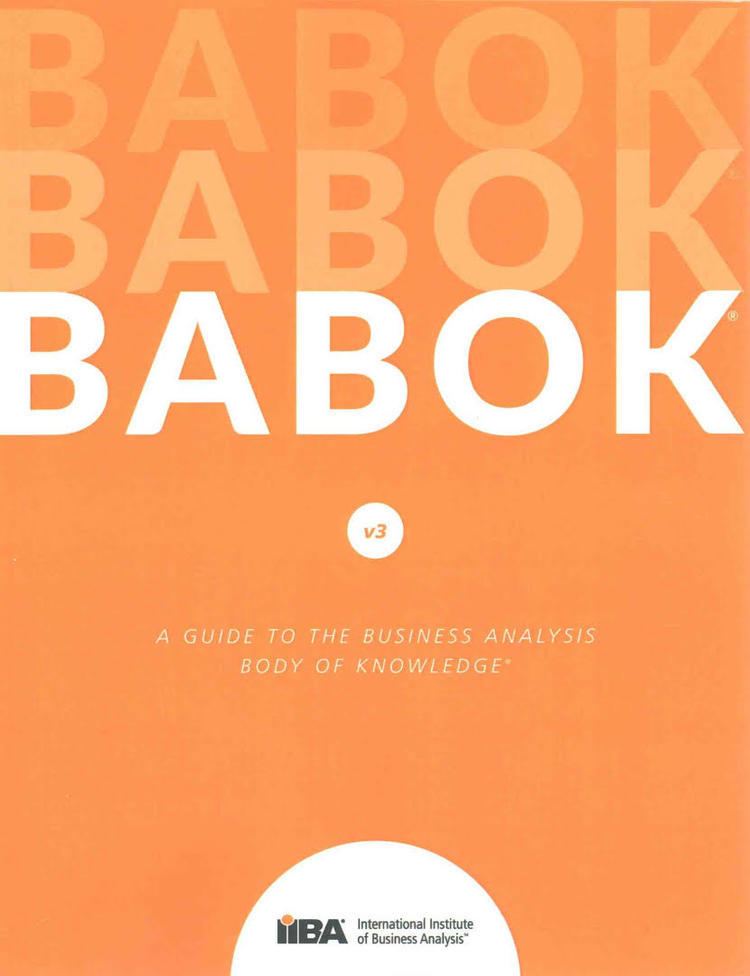7.4 /10 1 Votes
Originally published October 2005 | 3.7/5 Goodreads Editor Kevin Brennan | |||||||||||||||||||||||||||||||||
 | ||||||||||||||||||||||||||||||||||
Similar Project Management Body of K, Seven Steps to Mastering, PgMP, Getting it Right: Business, Parts Unknown: A Novel | ||||||||||||||||||||||||||||||||||
A Guide to the Business Analysis Body of Knowledge® (BABOK® Guide) is the globally recognized standard for the practice of business analysis. BABOK® Guide reflects the collective knowledge of the business analysis community and presents the most widely accepted business analysis practices.
Contents
- Business analyst training requirements elicitation techniques part 1
- History
- Professional Certification
- Structure and Content
- Knowledge Areas
- References
BABOK® Guide recognizes and reflects the fact that business analysis is continually evolving and is practised in a wide variety of forms and contexts. It defines the skills and knowledge that people who work with and employ business analysts should expect a skilled practitioner to demonstrate.
BABOK® Guide is a framework that describes the business analysis tasks that must be performed to deliver a solution that will provide value to the sponsoring organization. Each business analysis task contributes to this overall goal directly or indirectly. Many elements of a task may vary, including the form those tasks take, the order they are performed in, or the relative importance of the tasks.
BABOK® Guide describes the skills, knowledge, and competencies required to perform business analysis effectively. It does not describe the processes that people will follow to do business analysis.
According to Capability Maturity Model Integration, organizations interested in process improvement need to adopt industry standards from Business Analysis Body of Knowledge (and other associated references) to lift their project delivery from the ad hoc to the managed level.
Business analyst training requirements elicitation techniques part 1
History
BABOK® Guide was first published by International Institute of Business Analysis™ (IIBA®) as a draft document version 1.4, in October 2005, for consultation with the wider business analysis and project management community, to document and standardize generally accepted business analysis practices. The first formal release was at version 1.6 in June 2006. Version 2.0 was released 31 March 2009. Version 3 was released in April 2015.
BABOK® Guide is defined and updated by the professionals who use it every day and is under active review and consultation all the time. Prior to publication, BABOK® Guide undergoes a full public review where any person can provide feedback and comment on the content.
Professional Certification
Once the body of knowledge was established, IIBA created the Certified Business Analysis Professional™ (CBAP®) designation to recognise senior business analysts who could demonstrate in-depth long-term experience in these knowledge areas (5–10 years in a dedicated business analyst role).
IIBA also offers the Certification of Competency on Business Analysis™ (CCBA®) designation that recognises Business Analysts with 3750 hours business analysis experience, including 900 hours experience in two knowledge areas or 500 hours experience in four knowledge areas, and 21 professional development hours.
For both certifications the applicant must have a minimum high school education (or equivalent), two references from a career manager, client or Certified Business Analyst Professional and sign the IIBA Code of Conduct.
Structure and Content
BABOK® Guide includes chapters on:
Knowledge Areas
BABOK® Guide organizes business analysis tasks within 6 knowledge areas. Each task describes the typical knowledge, skills, deliverables, and techniques that the business analyst requires to be able to perform those tasks competently. The knowledge areas logically organize tasks but do not specify a sequence, process, or methodology.
The knowledge areas of BABOK® Guide are:
